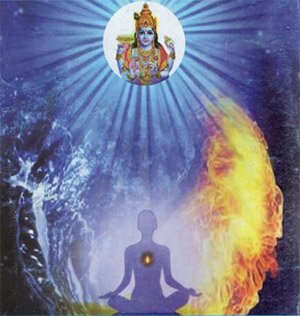Siddhanta Sangraha of Sri Sailacharya
by E. Sowmya Narayanan | 2008 | 30,562 words
Siddhanta Sangraha Chapter 19 (English translation), entitled “the causality of the goddess lakshmi” as included in the critical edition and study. The Siddhanta Samgraha is a Sanskrit philosophical text dealing with Vishishtadvaita in five hundred Sanskrit verses. It was written by Shri Shailacarya (18th century) and closely follows the philosophy of Vedanta Deshika (13th century).
Chapter 19 - The Causality of the Goddess Lakṣmī
173. The distinction between both the definition namely, nirūpaka and nirūpita in the extraordinary clause are clearly stated with illustrations in the Tattvatrayacintanādhikāra section of Śrīmad Rahasyatrayasāra Śāstra. The definition of the Supreme with the five aspects (i.e.) the satyatva etc., are common to the divine couple (divya dampatī).
174. These are the svarūpa lakṣaṇā for them. On the authority of Vedas and Śrī Pāñcarātra āgamas the brahmatva as been stated to the divine couple.[1]
175. According to the statement of the scriptures which declare the “One ness” of Brahman (advitīyatva) it has been objected that how can we accept the duality of Brahman in the divine couple as one? It is replied thus; the advitīyatva śruti only state the attribute or the nature is common to both and not the Brahman as dual which is qualified. This has been explained in the Vedānta Śāstras.[2]
176. The following statement is an authority to the above view, which is in the form of conversation of the divine couple Śrīman Nārāyaṇa and Goddess Lakṣmī. In this God says to Lakṣmī that “you possess the Brahman aspect that is conveyed by the expression Brahman. So we both are Brahman and let us be the cause of the Universe”.[3]
177. Thus, the divine couple possesses the same definition (eka lakṣaṇā) for them. And both are qualified by the citation of the difference between the world and Īśvara. So through the different explanations it is clearly stated that they are different from the world and the qualified nature of them is explained. So we say the Brahman as Śrī Viśiṣṭa Brahma.
178. Only the qualified Brahman is conveyed and understood by the causative statements and through the etymological and conventional interpretations for the word Nārāyaṇa. By the same method even Śrī is interpreted.
179. It is only the Nārāyaṇa śabda, which is qualified with Lakṣmī is explained through the components of that expression. The meaning thus derived is inherent in that expression. Thus, by both interpretations it is only Nārāyaṇa qualified with Śrī, is understood by that word. According to scriptures, when there is a contradiction in the meaning of an adjective (viśeṣaṇa) the qualified entity (viśeṣya) alone is sufficient for proving the fact. If there is no such contradiction then both are admitted.
180. In the scriptural statement that “ānītavāta svadhayātadekam” the ‘svadhā’ śabda refers to Śrī and Śrī Vyāsārya the author of Śrutaprakāśikā explains through the above scriptural statement that the qualified Brahman with Śrī (Śrī Viśiṣṭa Brahma) is the cause of the whole world.[4]
181-182. Through the upabrahmaṇa [upabrāhmaṇa?] for the above statement Śrī Vyāsārya establishes the cause of the world (jagat kāraṇatva) and the all-pervasiveness (vyāsakatva) to the divine couple. And also through the statement ‘śraddhayā devo devatvamaśnute’ it is described that the God creates the world in a sportive way along with Lakṣmī. Here the sportive creation (jagat vyāpāra līlā) of Goddess Lakṣmī is clearly exhibited. The same has been explained in detail in the commentary of Catuśślokī.[5]
183. According to the statements of Bhaṭṭāraka (Parāśarabhaṭṭa) the author of śrī guṇaratnakośa, the six attributes namely jñāna, śakti, bala, aiśvarya, vīrya, tejas are common to the divine couple. These qualities are present in them naturally.[6]
Footnotes and references:
[2]:
See Nyāya Siddhāñjana, pp.228-289
[3]:
See Lakṣmī Tantra, 3-1—See also Sanat Kumāra Saṃhitā.
[4]:
See Catuśślokībhāṣya, p.10
Conclusion:
 This concludes The Causality of the Goddess Lakshmi according to Vishishtadvaita philosophy explained by Shri Shailacarya. This book follows the model of Vedanta Deshika although the Vishishta Advaita school was originally expounded by Shri Ramanuja. Vishishta-Advaita is one of the various sub-schools of Vedanta which itself represents one of the six orthodox schools of Hindu Philosophy. They highlight the importance of the Upanishads, the Bhagavad Gita and the Brahma Sutras.
This concludes The Causality of the Goddess Lakshmi according to Vishishtadvaita philosophy explained by Shri Shailacarya. This book follows the model of Vedanta Deshika although the Vishishta Advaita school was originally expounded by Shri Ramanuja. Vishishta-Advaita is one of the various sub-schools of Vedanta which itself represents one of the six orthodox schools of Hindu Philosophy. They highlight the importance of the Upanishads, the Bhagavad Gita and the Brahma Sutras.
